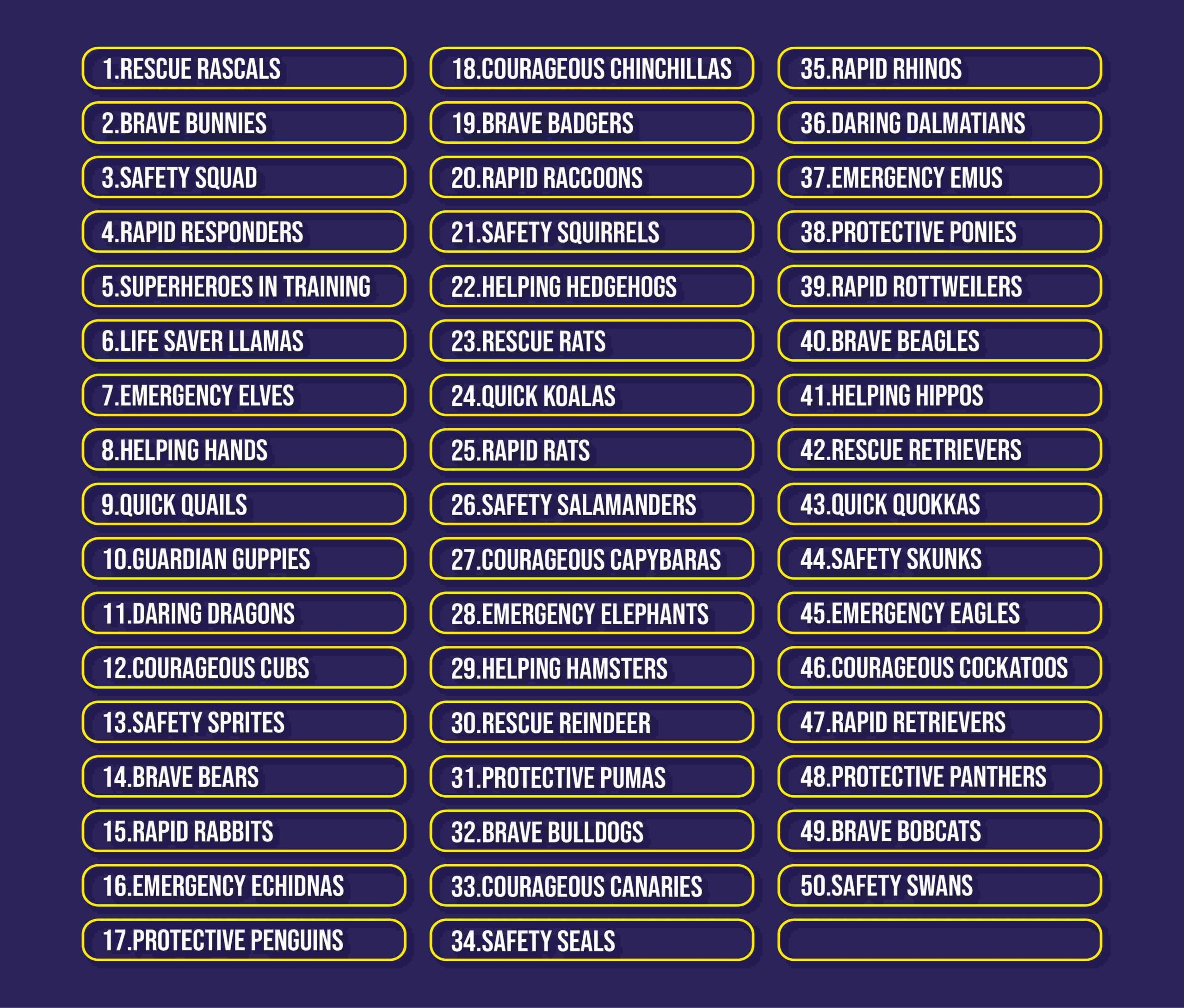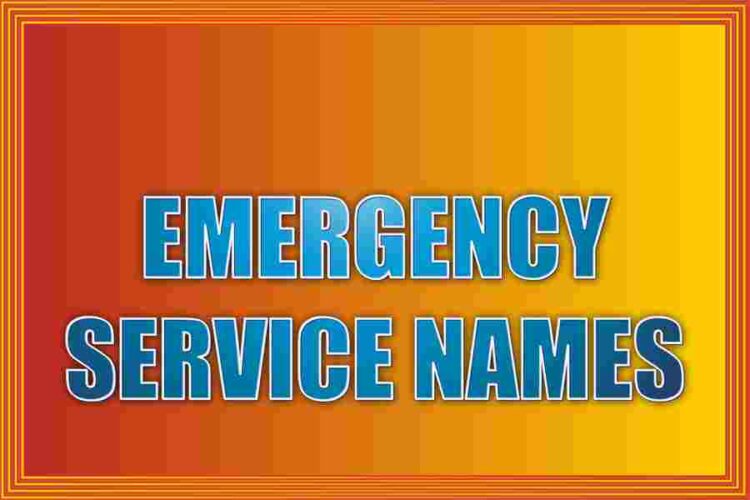Emergency services are critical components of any community’s infrastructure. They provide essential aid during emergencies, natural disasters, and other unforeseen events that threaten public safety. Emergency service names are the labels that are used to identify and describe these services. They play a critical role in ensuring that people can quickly and effectively access the help they need in emergency situations. This article will explore the common emergency service names, regional and cultural variations in naming, the evolution of emergency service names, their importance, and the challenges and controversies surrounding them. By the end of the article, readers will gain a comprehensive understanding of emergency service names and their importance in facilitating effective emergency response.
Importance Of Emergency Services
Emergency services are critical components of every community, and their importance cannot be overstated. Here are some key reasons why emergency services are vital:
- Protecting Public Safety: Emergency services are responsible for responding to a wide range of emergencies, including fires, medical emergencies, natural disasters, and criminal activities. These services help protect public safety by responding quickly and effectively to emergencies, minimizing damage, and saving lives.
- Providing Assistance to Those in Need: Emergency services provide essential assistance to people who are experiencing crises or emergencies. For example, EMS personnel can provide life-saving medical care, firefighters can rescue people from burning buildings, and police officers can intervene in dangerous situations.
- Supporting Community Resilience: Emergency services play an important role in supporting community resilience. By preparing for and responding to emergencies, these services help communities recover and rebuild after disasters and other crises.
- Promoting Public Trust and Confidence: Emergency services are often viewed as trustworthy and reliable institutions by the public. This trust and confidence are important in helping communities work together to respond to emergencies and ensure public safety.
Overall, emergency services are critical components of every community, and their importance cannot be overstated. These services play a vital role in protecting public safety, providing assistance to those in need, supporting community resilience, and promoting public trust and confidence.
Emergency Service Names
- 911 Emergency Services
- Police Department
- Fire Department
- Emergency Medical Services (EMS)
- Ambulance Services
- Search and Rescue (SAR)
- Coast Guard
- National Guard
- Federal Emergency Management Agency (FEMA)
- Red Cross
- Poison Control Center
- Bomb Squad
- Crisis Hotline
- Emergency Response Team
- Disaster Relief Team
- Hazmat Team
- Emergency Management Office
- Emergency Communication Center
- Emergency Operations Center
- Emergency Shelter
- Emergency Dispatch Center
- Emergency Medical Technician (EMT)
- Emergency Preparedness and Response Division
- Emergency Management Agency (EMA)
- Emergency Helpline
- Emergency Planning Department
- Emergency Support Function (ESF)
- Emergency Transportation
- Emergency Warming Center
- Emergency Rescue Squad
- Emergency Critical Care Transport (ECCT)
- Emergency Animal Rescue Service (EARS)
- Emergency Relief Fund
- Emergency Alert System (EAS)
- Emergency Notification System (ENS)
- Emergency Action Plan
- Emergency Medical Dispatch (EMD)
- Emergency Operations Plan
- Emergency Services Unit (ESU)
- Emergency Response Plan
- Emergency Medical Services Authority (EMSA)
- Emergency Management Coordinator
- Emergency Services Director
- Emergency Medical Services Instructor
- Emergency Management Consultant
- Emergency Preparedness Coordinator
- Emergency Medical Services Coordinator
- Emergency Management Specialist
- Emergency Medical Services Manager
- Emergency Planning and Research Division
Unique Emergency Services Names
- Rapid Response Team (RRT)
- Crisis Intervention Unit (CIU)
- Emergency Disaster Services (EDS)
- Trauma Response Team (TRT)
- Critical Incident Stress Management (CISM)
- Emergency Services Corps (ESC)
- Emergency Management and Preparedness Division (EMPD)
- Emergency Mental Health Services (EMHS)
- Mobile Health Emergency Response Team (MHERT)
- Community Emergency Response Team (CERT)
- Tactical Emergency Medical Services (TEMS)
- Emergency Medical Services for Children (EMSC)
- Community Paramedicine Program (CPP)
- Public Safety Answering Point (PSAP)
- Emergency Social Services (ESS)
- Medical Reserve Corps (MRC)
- Disaster Medical Assistance Team (DMAT)
- Joint Incident Management Team (JIMT)
- Mass Care and Sheltering Unit (MCSU)
- Rapid Intervention Team (RIT)
- Disaster Behavioral Health Response Team (DBHRT)
- Special Operations Response Team (SORT)
- Urban Search and Rescue (USAR)
- Mobile Integrated Healthcare (MIH)
- Emergency Operations Response Team (EORT)
- Tactical Response Unit (TRU)
- Emergency Communications Response Unit (ECRU)
- Incident Management Support Team (IMST)
- Emergency Management Planning and Coordination Unit (EMPCU)
- Emergency Preparedness and Response Program (EPRP)
- Crisis Management Team (CMT)
- Disaster Relief and Recovery Team (DRRT)
- Critical Care Transport (CCT)
- Tactical Medical Support (TMS)
- Emergency Management Support Unit (EMSU)
- Emergency Operations Center Support Team (EOCST)
- Medical Support Unit (MSU)
- Hazmat Response Team (HRT)
- Emergency Search and Rescue (ESR)
- Incident Response Team (IRT)
- Emergency Medical and Fire Services (EMFS)
- Disaster Response Medical Team (DRMT)
- Emergency Services Bureau (ESB)
- Incident Command System (ICS)
- Emergency Medical Response Team (EMRT)
- Emergency Support Services (ESS)
- Emergency Medical Dispatch Response Team (EMDRT)
- Disaster Services Response Team (DSRT)
- Emergency Response and Recovery Team (ERRT)
- Incident Support Team (IST)
Cute Emergency Services Names

Popular Emergency Services Names
- 911 Emergency Services
- Police Department
- Fire Department
- Emergency Medical Services (EMS)
- Ambulance Services
- Coast Guard
- National Guard
- Federal Emergency Management Agency (FEMA)
- Red Cross
- Poison Control Center
- Bomb Squad
- Crisis Hotline
- Disaster Relief Team
- Hazmat Team
- Emergency Operations Center
- Emergency Management Office
- Emergency Shelter
- Emergency Medical Technician (EMT)
- Emergency Response Team
- Emergency Critical Care Transport (ECCT)
- Emergency Animal Rescue Service (EARS)
- Emergency Relief Fund
- Emergency Alert System (EAS)
- Emergency Notification System (ENS)
- Emergency Action Plan
- Emergency Medical Dispatch (EMD)
- Emergency Operations Plan
- Emergency Services Unit (ESU)
- Emergency Response Plan
- Emergency Medical Services Authority (EMSA)
- Emergency Management Coordinator
- Emergency Services Director
- Emergency Medical Services Instructor
- Emergency Management Consultant
- Emergency Preparedness Coordinator
- Emergency Medical Services Coordinator
- Emergency Management Specialist
- Emergency Medical Services Manager
- Search and Rescue (SAR)
- Tactical Emergency Medical Services (TEMS)
- Community Emergency Response Team (CERT)
- Urban Search and Rescue (USAR)
- Joint Incident Management Team (JIMT)
- Disaster Medical Assistance Team (DMAT)
- Crisis Management Team (CMT)
- Critical Incident Stress Management (CISM)
- Emergency Social Services (ESS)
- Public Safety Answering Point (PSAP)
- Medical Reserve Corps (MRC)
- Mass Care and Sheltering Unit (MCSU)
Challenges And Controversies Surrounding Emergency Service Names
While emergency service names are essential for effective communication during emergencies, they can also present several challenges and controversies. Here are some of the most common issues:
- Confusion and Miscommunication: One significant challenge is confusion and miscommunication resulting from different names used for emergency services in different regions or cultures. This can lead to delays in response time or even misdirection of resources, which can have severe consequences.
- Political and Social Controversies: Emergency service names can also become the subject of political or social controversies, such as calls to defund or restructure police departments, debates over the use of certain military or law enforcement terminology, or discussions around the use of gender-neutral language.
- Inadequate Public Understanding: In some cases, the public may not fully understand the roles and responsibilities of different emergency services or their respective names, which can lead to confusion and difficulty in requesting the appropriate assistance.
- Evolving Language and Terminology: Language and terminology used in emergency services can evolve over time, which can lead to confusion or misunderstandings. For example, the terms “fireman” and “policeman” are no longer considered gender-neutral, and many departments have transitioned to using more inclusive language.
- Limited Resources and Funding: Emergency services often operate with limited resources and funding, which can impact their ability to effectively communicate with the public or maintain up-to-date technology and equipment to respond to emergencies.
Overall, the challenges and controversies surrounding emergency service names are complex and varied. However, efforts to address these issues, such as improved communication strategies and the use of more inclusive and culturally-sensitive language, can help improve emergency response and public safety.
Conclusion
Emergency service names are essential for effective communication during emergencies, allowing people to quickly and easily request the appropriate assistance. While there are many common emergency services names such as police department, fire department, and emergency medical services, there are also regional and cultural variations, as well as evolving terminology and language. While emergency services are critical components of every community, challenges, and controversies surround their names. Confusion and miscommunication, political and social controversies, inadequate public understanding, evolving language and terminology, and limited resources and funding are some of the challenges and controversies that can impact effective communication and response during emergencies.







